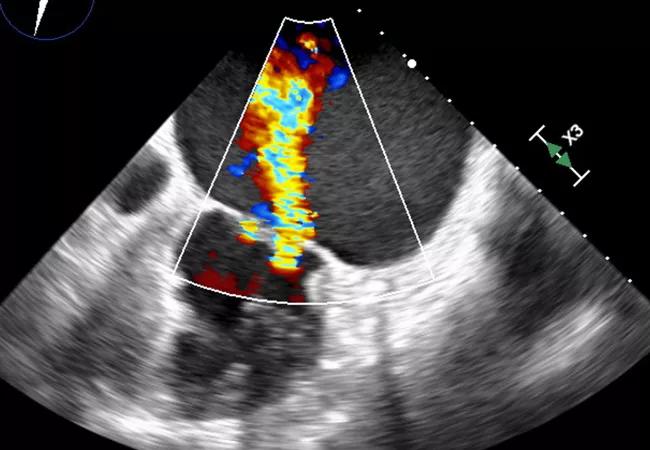How two Cleveland Clinic alliance hospitals systematically elevated echo standards

Echocardiography remains a cornerstone of cardiovascular care, offering vital insights into cardiac pathology and guiding clinical decision-making. Due to echocardiography’s highly operator-dependent nature, consistent image quality and interpretive accuracy hinge on a culture of continuous quality improvement (CQI).
Advertisement
Cleveland Clinic is a non-profit academic medical center. Advertising on our site helps support our mission. We do not endorse non-Cleveland Clinic products or services. Policy
Cleveland Clinic’s internal CQI program is structured to promote reliable delivery of high-quality echocardiographic studies. At its core is a standardized, routine and structured peer-review process that integrates seamlessly into daily clinical operations. Emphasizing collaboration and constructive feedback, the process involves both interpreting physicians and sonographers and aims to enhance the quality of image acquisition and interpretation across the board.
Through its Heart, Vascular and Thoracic Institute (HVTI) Advisory Services and Affiliate Program, Cleveland Clinic conducts comprehensive peer-to-peer evaluations for all its affiliate and alliance hospitals. At baseline, both professional and technical components are reviewed to assess interpretive accuracy, reporting consistency and technical optimization. Annually, a focused technical review is conducted on a selected sample of studies. These reviews equip sites with the tools necessary to implement and maintain internal quality assurance (QA) processes aligned with national imaging standards. Each review includes written feedback and targeted recommendations for improving technical performance and image quality.
The CQI program’s framework at Cleveland Clinic is scalable, serving as a template for other sites that wish to build or refine their own CQI systems. A structured, metrics-based approach ensures reproducibility and accountability in echocardiographic imaging. This article focuses on the technical reviews conducted by sonographers.
Advertisement
In the early phases of a site’s CQI implementation, Cleveland Clinic’s team partners to establish or expand the site’s internal quality programs. Teams are provided with:
Given the breadth and depth of criteria involved, a phased approach is encouraged. Sites begin with a manageable review volume, typically 2% to 3% of their annual study load, which gradually scales up as processes mature. All reviewed cases are randomly selected and remain confidential to ensure patient and staff privacy.
Personalized dashboards are created to provide each sonographer with detailed, data-driven insights into his or her technical performance. Key metrics include:
Advertisement
The dashboards allow sonographers to monitor their own trends over time. Constructive feedback is provided when performance declines, while sonographers who maintain high standards receive positive reinforcement. The goal is to drive individual accountability and foster continuous improvement and professional development. The tables and figure below present examples of some of the quality improvement reports generated.



Two hospitals that began their alliance with Cleveland Clinic HVTI in 2019 — Vassar Brothers Medical Center (Nuvance Health) in Poughkeepsie, New York, and Parkview Heart Institute in Fort Wayne, Indiana — have demonstrated outstanding leadership in CQI implementation. The teams at both hospitals demonstrate a consistent focus on continuous improvement and the provision of safe, high-quality patient care.
Vassar Brothers adopted a modified version of the Cleveland Clinic echocardiography protocol to ensure all critical imaging elements are captured consistently. This reflects the institution’s commitment to quality and alignment with best practices.
Vassar Brothers’ internal CQI process includes quarterly aggregation of review data into a comprehensive dashboard, presented during meetings of their echo team leadership. Cases rated “yellow” or “orange” trigger targeted peer reviews and designated improvement tasks. Common issues, such as excessively brief exam durations or measurement inaccuracies (e.g., leading-edge errors in aortic dimensions), are addressed through individual coaching and teamwide educational sessions. To prevent quality drift, experienced staff are paired with peer reviewers to promote accountability and mentorship across the team.
Advertisement
“Cleveland Clinic has been a wonderful resource as we strive to improve our quality assurance within the echocardiography department,” says Kashif Ather, MD, a cardiologist with Vassar Brothers. “The expertise and guidance their team offered us made a big difference in improving our technical standards. But the biggest credit goes to our sonographers and service line leads. The willingness of each member of the group to strive for excellence was integral to improving our program. We have seen the clear difference this makes in our quality metrics.”
Parkview implemented a CQI model closely aligned with Cleveland Clinic’s structure. The lab delivers personalized performance reviews and tracks progress through outcome reports, which are then used to inform ongoing education.
When diastolic function interpretation emerged as a common challenge, the team responded with structured learning sessions and algorithm refreshers during staff meetings. This proactive approach has improved both interpretive accuracy and staff confidence.
“Since our collaboration with Cleveland Clinic, the Parkview echocardiography team has seen our well-established QA program thrive, with enhancements that have boosted our performance to a higher standard,” says diagnostic imaging manager Veronica Holy-Carlson, RDCS. “Our echo staff appreciate the fine details of echo performance and look forward to the monthly reports.”
Both institutions have seen measurable gains in image quality and consistency. By connecting feedback to education and mentoring, they have built a collaborative culture that promotes excellence and lifelong learning.
Advertisement
“Regular quality assurance reviews in echocardiography are essential for delivering accurate, consistent and high-quality patient care,” says Suma Thomas, MD, MBA, Vice Chair of HVTI Strategic Operations and the Affiliate Program at Cleveland Clinic. “Our affiliate and alliance hospitals are advancing this process in alignment with our core values of excellence, innovation and continuous improvement.”
Cleveland Clinic’s HVTI Advisory Services Program is committed to supporting hospitals through strategic quality initiatives that encourage collaboration, promote best practices and provide tailored resources. By embedding CQI into everyday practice and linking performance feedback with professional development, affiliate and alliance sites are empowered to elevate their echocardiographic standards, driving better patient outcomes across their networks.
The next phase of quality enhancement includes incorporating or strengthening the professional CQI component to ensure consistent reporting accuracy. This initiative will help standardize interpretive practices, support ongoing physician education and reinforce alignment with national guidelines to further advance the quality and reliability of cardiovascular imaging across the system.
For information on affiliation or alliance opportunities with Cleveland Clinic’s Heart, Vascular and Thoracic Institute, visit clevelandclinic.org/hvtiadvisoryservices or email Amanda Lesesky at leseska@ccf.org.
Advertisement

Team provides coordinated, multidisciplinary, patient-centered care for high-risk pregnancies involving a heart defect

New Cleveland Clinic data challenge traditional size thresholds for surgical intervention

3 specialists share multidisciplinary perspectives on a widely impactful cardiovascular condition

Experience-based takes on valve-sparing root replacement from two expert surgeons

Two surgeons share insights on weighing considerations across the lifespan

Join us in Florida this winter for a long-standing CME favorite

BITA grafts themselves are rarely to blame, and outcomes can be good

First-in-human phase 1 trial induced loss of function in gene that codes for ANGPTL3